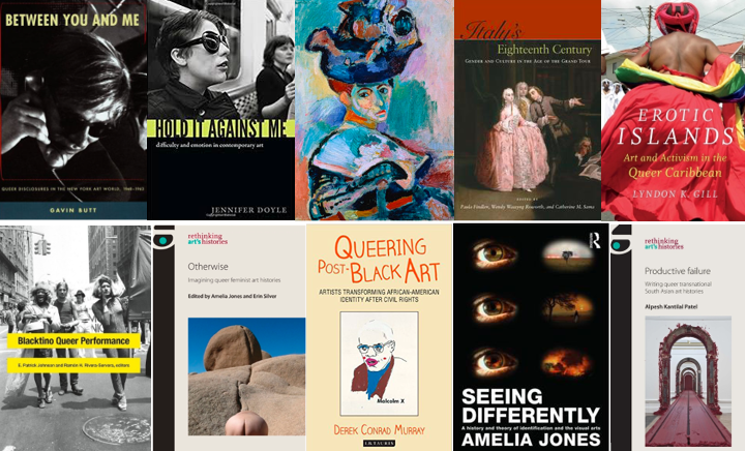CAA News Today
Countering Feminist Indifference: Notes from the Women’s Caucus for Art
posted by CAA — Aug 15, 2022
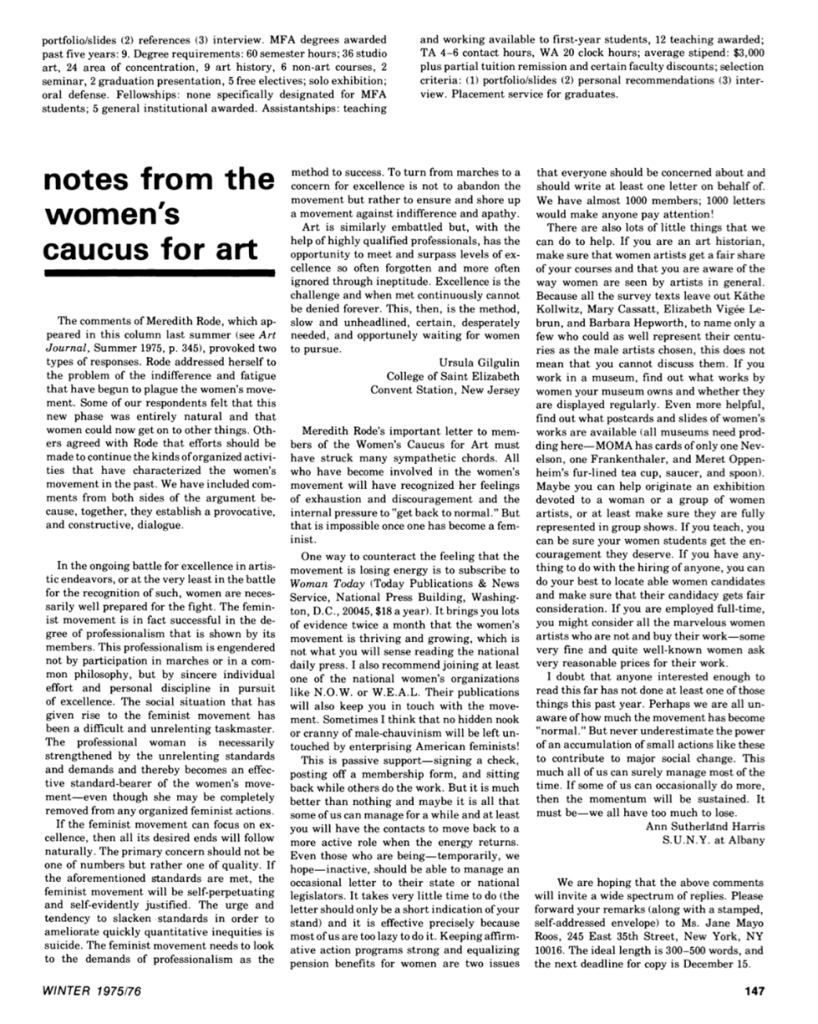
See full text reproduced below. Article also available on Jstor.
“Notes from the Women’s Caucus for Art (WCA),” a column featured in Art Journal during the 1970s, created an important forum for critical debates in the feminist art movement. In Summer 1975, for example, Meredith Rode shared evidence of fatigue with the feminist struggle in her letter “The High Price of Indifference.” Rode’s letter generated numerous responses in the winter 1975 issue, including Ann Sutherland Harris’s practical advice on how to counter this exhaustion.
The first President of WCA advocated both passive and activist gestures, ranging from sending a check to the National Organization of Women to pressuring local museums to display works by women in their collections, organizing group shows of women artists, mentoring female students, and buying women’s art.
This snapshot of WCA’s essential role in feminism art and activism reminds us how we can individually act to demand equity while working in conjunction with the collective efforts of essential national organizations, such as WCA and CAA. Read the full text below.
Post by Joanna Gardner-Huggett
Sources:
- Meredith Rode, “Notes from the Women’s Caucus for Art: The High Price of Indifference,” Art Journal (Summer 1975): 345.
- Ann Sutherland Harris, “Notes from the Women’s Caucus for Art,” Art Journal (Winter 1975/76): 147.
Biography of post author: Joanna Gardner-Huggett is an Associate Professor of History of Art and Architecture at DePaul University and Chair of the Committee on Women in the Arts. She teaches courses on twentieth-century art and feminist theory, while her research focuses on the intersection between feminist collaboration and arts activism and has been published in numerous journals and anthologies. Joanna’s most recent scholarship explores the history of the Chicago based women artists’ collectives Artemisia Gallery in Chicago (1973-2003), ARC Gallery (1973-present), and Sapphire and Crystals (1987-present).
FULL TEXT (from image): Ann Sutherland Harris, “Notes from the Women’s Caucus for Art,” Art Journal (Winter 1975/76): 147.
The comments of Meredith Rode, which appeared in this column last summer (see Art Journal, Summer 1975, p. 345), provoked two types of responses. Rode addressed herself to the problem of the indifference and fatigue that have begun to plague the women’s movement. Some of our respondents felt that this new phase was entirely natural and that women could now get on to other things. Other agreed with Rode that efforts should be made to continue the kinds of organized activities that have characterized the women’s movement in the past. We have included comments from both sides of the argument because, together, they establish a provocative, and constructive, dialogue.
In the going battle for excellence in artistic endeavors, or at the very least in the battle for the recognition of such, women are necessarily well prepared for the fight. The feminist movement is in fact successful in the degree of professionalism that is shown by its members. This professionalism is engendered not by participation in marches or in a common philosophy, but by sincere individual effort and personal discipline in pursuit of excellence. The social situation that has given rise to the feminist movement has been a difficult and unrelenting taskmaster. The professional woman is necessarily strengthened by the unrelenting standards and demands and thereby becomes an effective standard-bearer of the women’s movement—even though she may be completely remove from any organized feminist actions.
If the feminist movement can focus on excellence, then all its desire ends will follow naturally. The primary concern should not be one of the numbers but rather one of quality. If the aforementioned standards are met, the feminist movement will be self-perpetuating and self-evidently justified. The urge and tendency to slacken standards in order to ameliorate quickly quantitative inequities is suicide. The feminist movement needs to look to the demands of professionalism as the method to success. To turn from marches to a concern for excellence is not to abandon the movement but rather to ensure and shore up a movement against indifference and apathy.
Art is similarly embattled but, with the help of highly qualified professionals, has the opportunity to meet and surpass levels of excellence so often forgotten and more often ignored through ineptitude. Excellence is the challenge and when met continuously cannot be denied forever. This, then, is the method, slow and unheadlined, certain, desperately needed, and opportunely waiting for women to pursue.
Ursela Gilgulin, College of Saint Elizabeth, Convent Station, New Jersey
Meredith Rode’s important letter to members of the Women’s Caucus for Art must have struck many sympathetic chords. All who have become involved in the women’s movement will have recognized her feelings of exhaustion and discouragement and the internal pressure to “get back to normal.” But that is impossible once one has become a feminist.
One way to counteract the feeling that the movement is losing energy is to subscribe to Women Today. It brings you lots of evidence twice a month that the women’s movement is thriving and growing, which is not what you will sense reading the national daily press. I also recommend joining at least one of the national women’s organizations like N.O.W. or W.E.A.L. Their publications will also keep you in touch with the movement. Sometimes I think that no hidden nook or cranny of male-chauvinism will be left untouched by enterprising American feminists!
This is pass support—signing a check, posting off a membership form, and sitting back while others do the work. But it is much better than nothing and maybe it is all that some of us can manage for a while and at least you will have the contacts to move back to a more active role when the energy returns. Even those who are being—temporarily, we hope—in active, should be able to manage an occasional letter to their state or national legislators. It takes very little time to do (the letter should only be a short indication of your stand) and it is effective precisely because most of us are too lazy to do it. Keeping affirmative action programs strong and equalizing pension benefits for women are two issues that everyone should be concerned about and should write at least one letter on behalf of. We have almost 1000 members; 1000 letters would make anyone pay attention!
There are also lots of little things that we can do to help. If you are an art historian, make sure that women artists get a fair share of your courses and that you are aware of the way women are seen by artists in general. Because all the survey texts leave out Käthe Kollwitz, Mary Cassatt, Élisabeth Louise Vigée Le Brun, and Barbara Hepworth, to name only a few who could as well represent their centuries as the male artists chosen, this does not mean that you cannot discuss them. If you work in a museum, find out what works by women your museum owns and whether they are displayed regularly. Even more helpful, find out what postcards and slides of women’s works are available (all museums need prodding here—MOMA has cards of only one Nevelson, one Frankenthaler, and Meret Oppenheim’s fur-lined tea cup, saucer, and spoon). Maybe you can help originate an exhibition devoted to a woman or a group of women artists, or at least make sure they are fully represented in group shows. If you teach, you can be sure your women students get the encouragement they deserve. If you have anything to do with the hiring of anyone, you can do your best to locate able women candidates and makes sure that their candidacy gets fair consideration. If you are employed full-time, you might consider all the marvelous women artists who are not and buy their work—some very fine and quite well-known women ask very reasonable prices for their work.
I doubt that anyone interested enough to read this far has not done at least one of these things this past year. Perhaps we are all unaware of how much the movement has become “normal.” But never underestimate the power of an accumulation of small actions like these to contribute to major social change. This much all of us can surely manage most of the time. If some of us can occasionally do more, then the momentum will be sustained. It must be—we all have too much to lose.
Ann Sutherland Harris, S.U.N.Y at Albany
In 1972, CAA founded its first committees devoted to women in the arts. As a part of this yearlong 50th anniversary celebration, we are sharing historic materials from CAA members and archives that intersect with feminism at the organization, including CAA’s Committee on Women in the Arts (CWA) and our Affiliated Societies, Women’s Caucus for Art (WCA) and The Feminist Art Project (TFAP).
This celebration culminates in a program and reception at Boston University’s Joan and Edgar Booth Theatre on Friday, September 23, 2022. This program will reflect upon the incredible history of feminist pioneers at the organization while looking toward a more inclusive, equitable future through the continued work of the CWA. The members of CWA are carrying the torch of feminism during this crucial time of precarity for women’s rights.
Over the next couple months, visit this site (CAA News) and our social media pages to explore more about this history and items from our archives.
Members’ Corner: Former CAA President Judith Brodsky Co-Curates Retrieving the Life and Art of James Wilson Edwards And A Circle of Black Artists
posted by CAA — Jul 25, 2022

African Sky, an oil painting by James Wilson Edwards, will be included in the Arts Council of Princeton’s Retrieving the Life and Art of James Wilson Edwards and a Circle of Black Artists, an exhibition featuring the work of a diverse and vibrant regional arts community not acknowledged in contemporary American art history on view at the Arts Council of Princeton this October.
The Arts Council of Princeton will present a revolutionary exhibition in October 2022. Retrieving the Life and Art of James Wilson Edwards and a Circle of Black Artists reveals how Black artist/teachers were integral and influential members in a predominantly white regional community in the last quarter of the 20th century. While there have been blockbuster exhibitions of a few contemporary Black artists during recent years of efforts by museums and galleries to become more diverse, this is one of the first exhibitions to explore the historical context from which these artists emerged.
Co-curators Judith K. Brodsky and Rhinold Ponder say “this has been a magnificent voyage of discovery about the lives and roles in art history of Black artists who have largely been forgotten or ignored as well as a reminder of the significance of Black collectors in preserving and promoting the history of Black artists and ensuring that they are eventually remembered for their contributions. We trust that our efforts here encourage others to restore Black artists and arts communities to their rightful places in American national and regional histories.” Brodsky is a Distinguished Professor Emerita at the Department of Visual Arts at Rutgers and previously served as a president of CAA. Ponder is an artist, activist, writer, lawyer, and founder of Art Against Racism.
This exhibition focuses on five late 20th-century master artists who lived and worked within 25 miles of each other in the geographic region from Princeton, New Jersey to New Hope, Pennsylvania: James Wilson Edwards, Rex Goreleigh, Hughie Lee-Smith, Selma Hortense Burke, and Wendell T. Brooks. These Black artists represent a diverse and vibrant regional arts community largely unknown in contemporary American art history. Nearly all the works in this exhibition come from private collections, highlighting the importance of collectors of color in restoring Black and brown artists to American art history and how their collecting sheds light on the systemic racism of the American art world. Recent attention to diversity in museum collections has revealed that only 1.2% of the holdings are by African American artists.
Retrieving the Life and Art of James Wilson Edwards and a Circle of Black Artists will be on view in the Arts Council of Princeton’s Taplin Gallery from October 14 through December 3, 2022 and will include an opening reception, panel discussion, and more. Additional information can be found on the Art Council of Princeton’s website.
CAA Museum Committee: Call for Professionals
posted by CAA — Jul 12, 2022
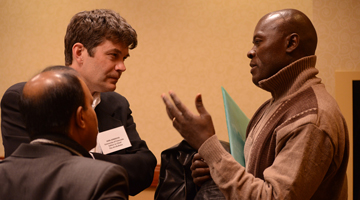
The CAA Museum Committee seeks CAA, AAM, AAMG, other professional organization members, and/or museum studies educators, to join the review process to revise the CAA Tools for Museum Professionals. The asynchronous review of seven standards and guidelines will begin in late summer and continue through the fall. Contributor credit will be included in the authors byline of the revised standards and guidelines document(s) following their approval.
Topics for review include:
- Curriculum Vitae for Museum Professionals
- Guidelines for Museums or Other Not-For-Profit Visual-Arts Institutions Working with Artists on Exhibitions and Commissioned Works
- Guidelines Regarding the Hiring of Guest Curators by Museums
- Information about Museum Ethics and Professional Practices
- Professional Practices for Art Museum Curators
- Statement Concerning the Acquisition of Cultural Properties Originating from Abroad, from Indigenous Cultures, and from Private Collections during the Nazi Era
- Statement Concerning the Deaccession of Works of Art
Please email a letter of interest with a short statement about your experience and expertise to Monica Andrews, contactstudiomda@gmail.com. Deadline: August 17.
CAA-Getty International Program 2023: Applications now open!
posted by CAA — Jul 06, 2022
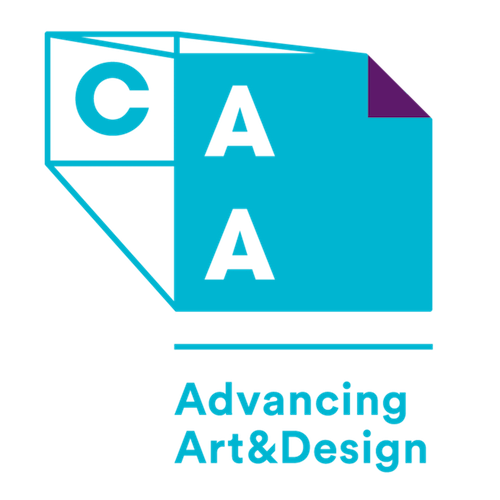

The Getty Foundation has awarded the College Art Association (CAA) a grant to fund the CAA-Getty International Program for a twelfth consecutive year. The Foundation’s support will enable CAA to bring twelve international visual-arts professionals to the 111th Annual Conference, taking place New York, NY, February 15–18, 2023. These individuals will be first-time participants in the program and will be accompanied by alumni of the program returning to present papers during the conference.
Participants will receive funds for travel expenses, hotel accommodations, per diems, conference registrations, and one-year CAA memberships. We encourage all international art historians, art history educators, and museum curators to apply. The program will also include a one-day preconference colloquium on international issues in art history on Tuesday, February 14, as well as ongoing engagement with other alumni from the program online and at future conferences. The deadline for applications is August 15, 2022. Guidelines and application can be found here.
Last year, CAA organized a publication to celebrate ten successful years of the CAA-Getty International Program. The publication, entitled Global Conversations: 10 Years of the CAA-Getty International Program features in-depth accounts of the program, a timeline of important events and milestones, and directories of past papers, members, and meetings.
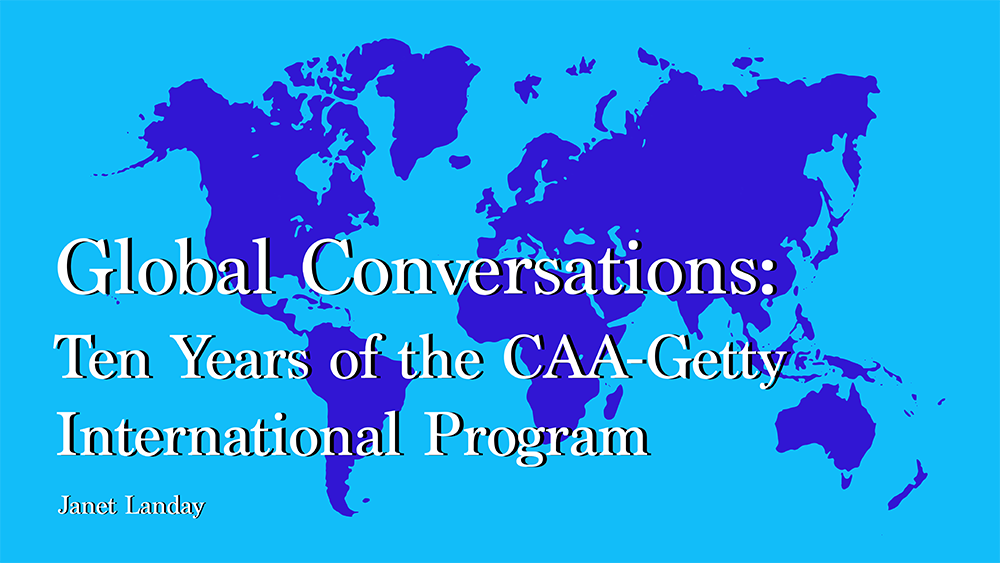
The CAA-Getty International Program was established to increase international participation in CAA and the CAA Annual Conference. The program fosters collaborations between North American art historians, artists, and curators and their international colleagues and introduces visual arts professionals to the unique environments and contexts of practices in different countries.
Since it began in 2012, the program has brought 147 scholars to the conferences, from over 50 countries located in Central and Eastern Europe, Asia, Southeast Asia, Africa, the Caribbean, and Central and South America. Each year, a preconference colloquium on international topics in art history inaugurates the week, kicking off four days of conference sessions, meetings with new colleagues, and visits to museums and galleries. Subsequent to these events, the program has generated many scholarly collaborations, including publications, conferences, and exhibitions.
Most of all, former grant recipients have become ambassadors of CAA in their countries, sharing knowledge gained at the Annual Conference with their colleagues at home. Past recipients have said that “variety of topics presented also exposed me to the realization that there is so much to be done to unearth the hidden treasures of global art history, which hitherto I have overlooked in my discipline and nation but which will now form the basis of my future projects,” and “the direct contact with other global south researchers is an unique occasion, rarely possible and extremely enriching.”
IN MEMORIAM: SAM GILLIAM
posted by CAA — Jun 30, 2022
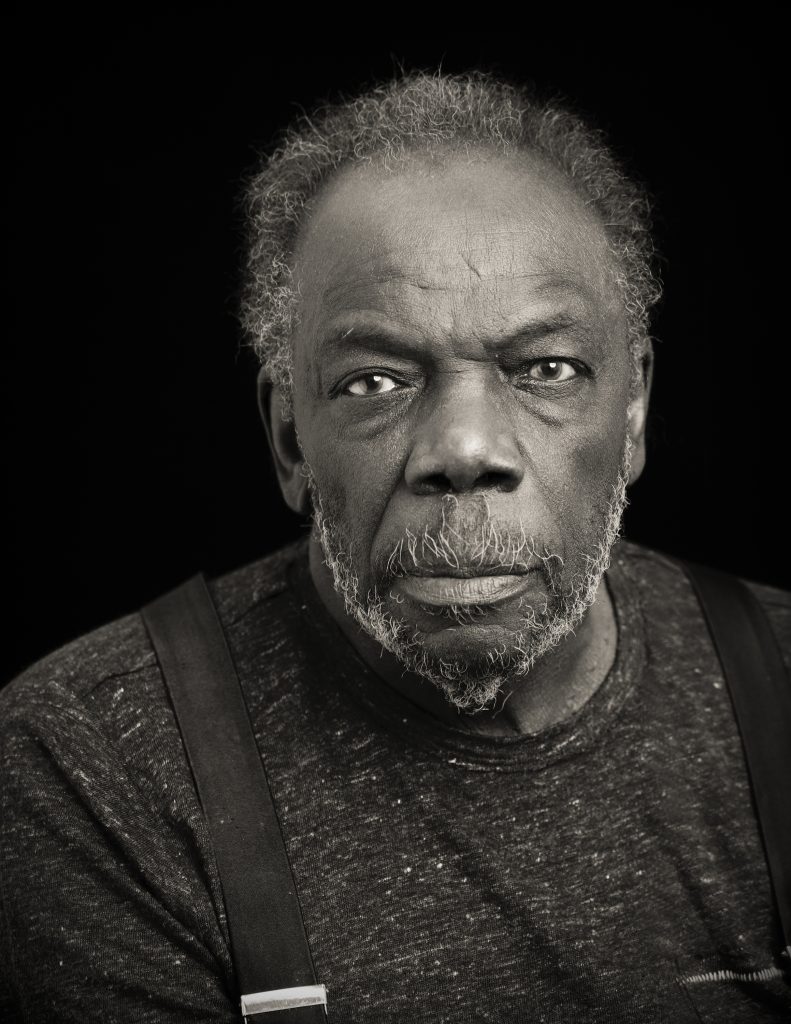
Photograph provided by Pace Gallery
Sam Gilliam, the famous and groundbreaking abstract American painter, died in his home in Washington D.C. on June 25 at the age of 88. A part of the Washington Color Field painters of the 1960s, Gilliam freed his paintings from traditional supports and became well known for draping and folding his abstract canvases. Interested in color, form, and process, his approach combined painting with sculpture, and used pouring and staining techniques to create broad fields of color.
His works are included in many of the nation’s most prominent art collections and museums, including the Metropolitan Museum of Art, the Museum of Modern Art, the Tate Modern, and the National Gallery of Art.
Gilliam’s enormous draped canvases were the most visible aspect of his career, but he also supported his fellow artists through collectives, mentorship, and service. As a lifetime member of CAA he contributed actively to the CAA community in myriad ways – donating artwork, serving on juries for our distinguished awards, serving on committees, and sitting on our board of directors.
As the chair of the Sub-Committee on Public Art of the CAA Artists’ Committee he helped draft our 1987 standards and guidelines for public artworks. This was revised and reapproved in February of 2022 and remains a canonical guide for artists working in the public realm.
He also donated artwork alongside Kiki Smith, Faith Ringgold, and Miriam Shapiro to support CAA’s Professional Development Fellowship Program in the early 2000s.
In addition, he volunteered his time as a board member from 1985-1988 and served on our juries for the CAA Artist Award for a Distinguished Body of Work and Distinguished Artist Award for Lifetime Achievement.
Read more about his career here.
Pride Month and caa.reviews
posted by CAA — Jun 02, 2022
This Pride Month, we highlight the rich scholarship and programs produced at CAA that center LGBTQ+ topics, as well as gender and sexual identity, in the fields of visual arts and the humanities. This week, we are sharing a bibliography of publications and exhibitions on these topics reviewed this past year on our open-access journal caa.reviews.
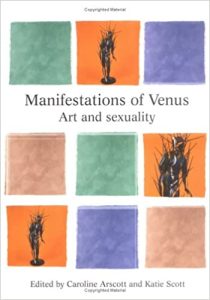 |
Arscott, Caroline and Katie Scott, editors. Manifestations of Venus: Art and Sexuality. Manchester: Manchester University Press, 2001. |
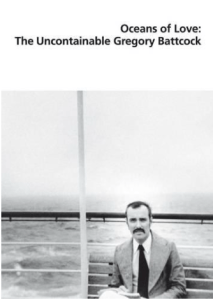 |
Battcock, Gregory. Oceans of Love: The Uncontainable Gregory Battcock. Ed Joseph Grigely, Cologne, Germany: Verlag der Buchhandlung Walther Konig, 2016. |
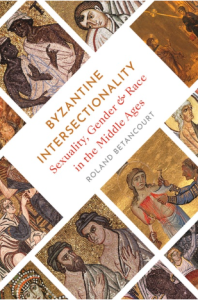 |
Betancourt, Roland. Byzantine Intersectionality: Sexuality, Gender, and Race in the Middle Ages. Princeton, NJ: Princeton University Press, 2020. |
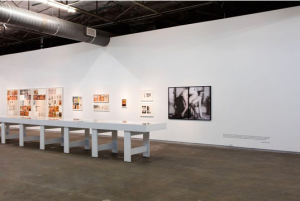 |
Black Sheep Feminism: The Art of Sexual Politics. Dallas: Dallas Contemporary, 2016. |
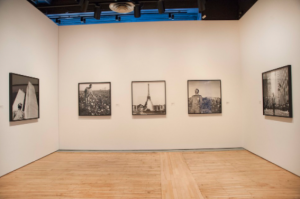 |
Brandt, Amy ed. Tseng Kwong Chi: Performing for the Camera. Norfolk, VA and New York: Chrysler Museum of Art, Grey Art Gallery, New York University, and Lyon Artbooks, 2015. |
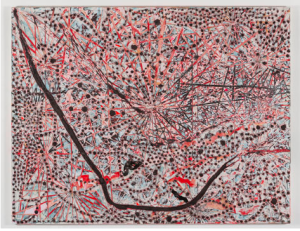 |
Butler, Connie. Mark Bradford: Scorched Earth. Exh. cat. Los Angeles: Hammer Museum in association with Prestel, 2015.
Mark Bradford. Lights and Tunnels, 2015 (photograph © 2015 Joshua White; provided by Hauser & Wirth) |
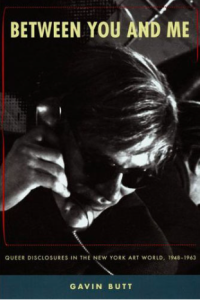 |
Butt, Gavin. Between You and Me: Queer Disclosures in the New York Art World, 1948–1963. Durham, NC: Duke University Press, 2005.
|
 |
De Salvo, Donna. Andy Warhol: From A to B and Back Again. Exh. cat. New Haven and New York: Yale University Press in association with The Whitney Museum of American Art, 2018.
Installation view, Andy Warhol—From A to B and Back Again, Whitney Museum of American Art, New York, November 12, 2018–March 31, 2019 (photograph © 2018 by Ron Amstutz, provided by The Andy Warhol Foundation for the Visual Arts, Inc./Licensed by Artists Rights Society [ARS], New York) |
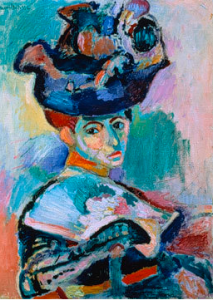 |
Corn, Wanda M. and Tirza True Latimer. Seeing Gertrude Stein: Five Stories. Exh. cat. Berkeley: University of California Press, 2011.
Henri Matisse. Woman with a Hat (1905). Oil on canvas. 31 3/4 x 23 1/2 in. (80.7 x 59.7 cm). SFMOMA, Bequest of Elise S. Haas. © Succession H. Matisse, Paris / Artists Rights Society (ARS), New York. Photo: Ben Blackwell |
 |
Doyle, Jennifer. Hold It Against Me: Difficulty and Emotion in Contemporary Art. Durham: Duke University Press, 2013. |
 |
Findlen, Paula, Wendy Wassyng Roworth, and Catherine M. Sama, editors. Italy’s Eighteenth Century: Gender and Culture in the Age of the Grand Tour. Stanford: Stanford University Press, 2009. |
 |
Gallucci, Margaret A. Benvenuto Cellini: Sexuality, Masculinity, and Artistic Identity in Renaissance Italy. New York: Palgrave Macmillan, 2003. |
 |
Gill, Lyndon K. Erotic Islands: Art and Activism in the Queer Caribbean. Durham, NC: Duke University Press, 2018. |
 |
Gómez-Barris, Macarena. Beyond the Pink Tide: Art and Political Undercurrents in the Americas. American Studies Now: Critical Histories of the Present. Oakland: University of California Press, 2018. |
 |
Guyton, Wade. One Month Ago. Edition of 500. New York: Karma, 2014. |
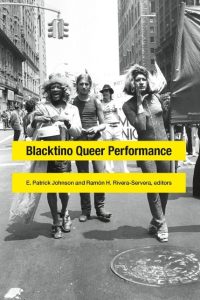 |
Johnson, E. Patrick and Ramón H. Rivera-Servera, editors. Blacktino Queer Performance. Durham: Duke University Press, 2016. |
 |
Jones, Amelia. Seeing Differently: A History and Theory of Identification and the Visual Arts. New York: Routledge, 2012. |
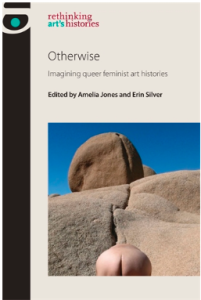 |
Jones, Amelia and Erin Silver. Otherwise: Imagining Queer Feminist Art Histories. Manchester: Manchester University Press, 2016.
With follow-up interview between Amelia Jones and David J. Getsy, Abstract Bodies and Otherwise: A Conversation with Amelia Jones and David Getsy on Gender and Sexuality in the Writing of Art History. February 16, 2018 |
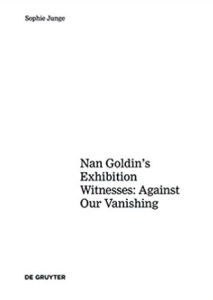 |
Junge, Sophie. Art about AIDS: Nan Goldin’s Exhibition Witnesses: Against Our Vanishing Berlin: De Gruyter, 2017. |
 |
Katz, Jonathan David and Rock Hushka, editors. Art AIDS America. Exh. cat. Seattle: Tacoma Art Museum in association with University of Washington Press, 2015.
Courtesy of the Zuckerman Museum of Art. Photos by Mike Jensen |
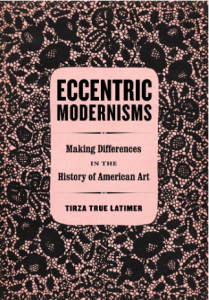 |
Latimer, Tirza True. Eccentric Modernisms: Making Differences in the History of American Art. Oakland: University of California Press, 2016. |
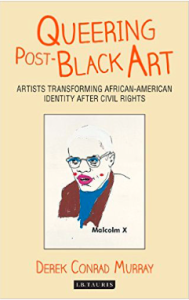 |
Murray, Derek Conrad. Queering Post-Black Art: Artists Transforming African-American Identity after Civil Rights. London: I.B. Taurus, 2016. |
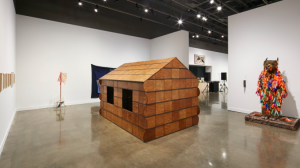 |
No Wrong Holes: Thirty Years of Nayland Blake. Institute of Contemporary Art, Los Angeles, September 29, 2019–January 26, 2020; MIT List Visual Arts Center (online), Cambridge, MA, October 16, 2020–February 14, 2021.
No Wrong Holes: Thirty Years of Nayland Blake, installation view, MIT List Visual Arts Center, Cambridge, MA, 2020–21 (photograph © Charles Mayer, provided by MIT List Visual Arts Center) |
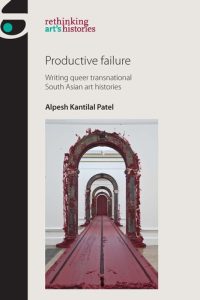 |
Patel, Alpesh Kantilal. Productive Failure: Writing Queer Transnational South Asian Art Histories. Manchester, UK: Manchester University Press, 2017. |
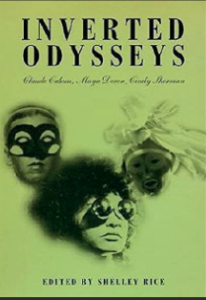 |
Rice, Shelley. Inverted Odysseys: Claude Cahun, Maya Deren, Cindy Sherman. Cambridge, Mass.: MIT Press, 1999. |
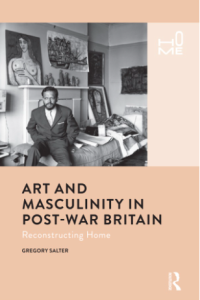 |
Salter, Gregory. Art and Masculinity in Post-War Britain: Reconstructing Home. London: Routledge, 2019. |
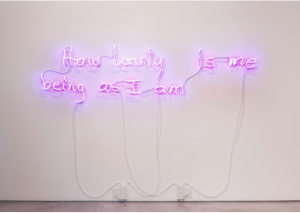 |
Transamerica/n: Gender, Identity, Appearance Today. McNay Art Museum, San Antonio, June 20–September 15, 2019.
Jacolby Satterwhite, How lovly is me being as I am, 2014, neon, installation view from Transamerica/n: Gender, Identity, Appearance Today, McNay Art Museum, San Antonio, 2019 (artwork © Jacolby Satterwhite; photograph provided by the artist and Morán Morán, Los Angeles) |
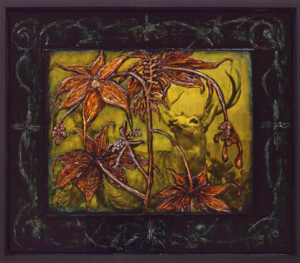 |
Tony Greene: Room of Advances. MAK Center for Art and Architecture, Schindler House, Los Angeles, June 18–September 7, 2014.
Tony Greene. His Puerile Gestures (1989). Mixed Media. 25 1/2 x 29 3/4 in. Collection of Ray Morales, from the estate of Norm MacNeil |
 |
Turner, James Grantham. Eros Visible: Art, Sexuality and Antiquity in Renaissance Italy. New Haven: Yale University Press, 2017. |
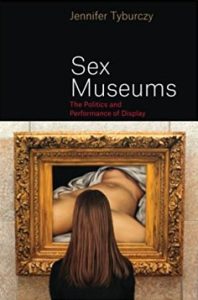 |
Tyburczy, Jennifer. Sex Museums: The Politics and Performance of Display. Chicago: University of Chicago Press, 2016. |
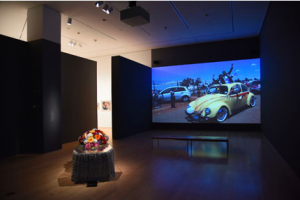 |
Zanele Muholi: Isibonelo/Evidence. Brooklyn Museum, New York, May 1–November 8, 2015.
Zanele Muholi: Isibonelo/Evidence. Installation view. Courtesy of the Brooklyn Museum. |

Announcing the Terra Foundation for American Art Research Travel Grant Recipients for 2022
posted by CAA — May 09, 2022
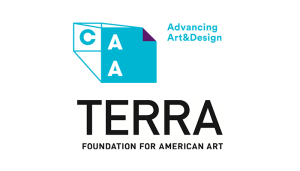
We’re delighted to announce that twenty-four scholars have been awarded Terra Foundation for American Art Research Travel Grants in 2022.
These grants provide support to doctoral, postdoctoral, and senior scholars from both the US and outside the US for research topics dedicated to the art and visual culture of the United States prior to 1980.
The Terra Foundation prioritizes projects that interrogate and broaden definitions of American art and lends support for projects engaged in transforming or complicating how the story of American art is told. To expand histories of American art, we encourage projects that reflect a commitment to inclusive and equitable research and museum practice; generate new scholarship and interpretive frameworks; employ critical methodologies and innovative models; and/or engage diverse partners and audiences.
INTERNATIONAL RESEARCH TRAVEL GRANTS FOR US-BASED SCHOLARS
Doctoral Scholars
Manon Gaudet, Yale University, “Beyond Landscape: Property and the Contested Ground of North American Visual Culture, 1900-1945”
Michaela Haffner, Yale University, “The Visual Culture of Naturopathic Cures & the Fashioning of White Wellness”
Annie Ochmanek, Columbia University, “Conceptualism and the Connexionist World: The Art of Eduardo Costa, Hannah Weiner, Christine Kozlov, and Stanley Brouwn”
Constanza Robles, Boston University, “Visualizing Alliances through Art and Architecture: Pan Americanism, Hispanismo and Latin Americanism in World Fairs, 1901-1929”
Lea Stephenson, University of Delaware, “’Wonderful Things’: Egyptomania, Empire, and the Senses, 1870-1922”
Postdoctoral & Senior Scholars
Maria Elena Buszek, University of Colorado, Denver, “Art of Noise: Feminist Art and Popular Music
John J. Curley, Wake Forest University, “Critical Distance: Black American Artists in Europe 1957-1968”
Emily Voelker & Erin Hyde Nolan, UNC Greensboro and Maine College of Art, “Reading Native American Portraits in Ottoman: Global Economies of Nineteenth-century Survey Photograph”
INTERNATIONAL RESEARCH TRAVEL GRANTS TO THE UNITED STATES
Doctoral Scholars
Marion Belouard, University of Limoges, “Painting nature, exchanging knowledge. John James Audubon (1785-1851), a rare bird in Atlantic history?”
Cora Chalaby, University College London, “Control Systems: Helen Frankenthaler, Joan Mitchell, Alma Thomas, and Howardena Pindell’s Orderly Abstractions”
Clara Johanna Lauffer, Central Institute for Art History, Munich, “Rewriting the ‘pictures generation’: the production of white masculinity in appropriation art”
Mylène Palluel, Université Paris 1 Panthéon-Sorbonne, “The ‘Longue durée’ paradigm in 1960s American art and social sciences. Case studies in Minimal Art, Conceptual Art and Land Art”
Mona Schubert, University of Cologne, “Photographic Media at documenta in the 1970s and the US-American Art Scene”
Clara Royer, Université Paris 1 Panthéon-Sorbonne, “Slow-Scan: the (geo)political turn of media arts (1960-1990)”
Yana Shtilman, Université de Paris, “Public image, private lives: Creating the image of the “New Negro” woman in the Harlem Renaissance (1920-1943)”
Achang Su, China Academy of Art, “The Identity Issues and Abstract Transformation in the works of Modern Chinese-American Artist George Chann from 1950s to 1960s”
Postdoctoral & Senior Scholars
Alice Butler, Courtauld Institute of Art, “The Perversions of Textile in Feminist Art”
Anne-Claire Faucquez, Université Paris 8, “The narrativization of colonial slavery in American museums: arts and representations” (collaborating with Androula Michael)
Roula Matar, École nationale supérieure d’architecture de Versailles, “James Johnson Sweeney’s Contribution to a Critical and Didactical Approach to Exhibition Installation”
Androula Michael, Université de Picardie Jules Verne – UFR des arts, “The narrativization of colonial slavery in American museums: arts and representations” (collaborating with Anne-Claire Faucquez)
Yvonne Schweizer, Eberhard Karls Universität Tübingen, “Linking Mediatization and Mediation. Art Institutions as Media Producers since 1970”
Harry Weeks, Newcastle University, “The Artist’s Second Shift”
Andrew Witt, Humboldt-Universität zu Berlin, “Exile Modernism: Photography c. 1940”
LEARN MORE ABOUT THE TERRA FOUNDATION RESEARCH TRAVEL GRANTS
Nominations Open for CAA Juries
posted by CAA — Apr 21, 2022
CAA invites nominations and self-nominations for individuals to serve on our Awards for Distinction, Publication Grant, Fellowship, and Travel and Support Grant juries. Terms begin July 2022.
Candidates must possess expertise appropriate to the jury’s work and be current CAA members. They should not hold a position on a CAA committee or editorial board beyond May 31, 2022. CAA’s president and vice president for committees appoint jury members for service. Materials are due to CAA by June 1, 2022.
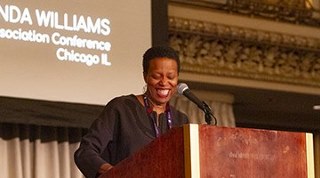
Amanda Williams speaks at Convocation at CAA’s 108th Annual Conference in Chicago
AWARDS FOR DISTINCTION JURIES
CAA has vacancies in the following juries for the annual Awards for Distinction for three years (2022–2025). Terms begin in July 2022.
- The Alfred H. Barr Jr. Award/Alfred H. Barr Jr. Award for Smaller Museums, Libraries, Collections, and Exhibitions for museum scholarship (3 vacancies)
- Charles Rufus Morey Book Award for non-catalogue books in the history of art (2 vacancies)
- Frank Jewett Mather Award for art criticism (1 vacancy)
- Arthur Kingsley Porter Prize for Art Bulletin articles (2 vacancies)
- The CAA/American Institute for Conservation Award for Distinction in Scholarship and Conservation (2 vacancies)
- Jury for the Artist Award for Distinguished Body of Work, Distinguished Artist Award for Lifetime Achievement, and Distinguished Teaching of Art Award (1 vacancy)
- Jury for the Distinguished Teaching of Art History Award and the Distinguished Lifetime Achievement Award for Writing on Art (3 vacancies)
- Distinguished Feminist Awards for Scholars and Artists (1 vacancy)
PUBLICATION GRANT JURIES
CAA has vacancies on our Publication Grant juries for three years (2022–2025). Terms begin in July 2022.
- Millard Meiss Publication Fund (2 vacancies)
PROFESSIONAL DEVELOPMENT FELLOWSHIP JURIES
CAA has vacancies on our Professional Development Fellowship juries for three years (2022–2025). Terms begin in July 2022.
- Professional Development Fellowship in Art History (2 vacancies)
TRAVEL/SUPPORT GRANT JURIES
CAA has vacancies on our jury for three years (2022–2025). Terms begin in July 2022.
- CAA Support Grant in Memory of Archibald Cason Edwards, Senior, and Sarah Stanley Gordon Edwards (2 vacancies)
- Art History Fund for Travel to Special Exhibitions (2 vacancies)
HOW TO APPLY
Nominations and self-nominations should include a brief statement (no more than 150 words) outlining the individual’s qualifications and experience and a CV (an abbreviated CV no more than two pages may be submitted). Please send all materials by email to Cali Buckley: cbuckley@collegeart.org. Nominations must be sent as a Microsoft Word or Adobe PDF attachment.
For questions about jury service and responsibilities, contact info@collegeart.org.
Deadline: June 1, 2022
CWA Picks: March/April 2022
posted by CAA — Apr 21, 2022
The March and April “picks” include exhibitions that encourage viewers to reframe familiar historical narratives and hierarchies. The content explored by these artists ranges from political icons to advertising and myth; and their approaches weave together tradition with experimentation. The works in these exhibitions move between the past and the present, providing a perspective tied to both individual and collective memory.
Angela Davis — Seize the Time
September 08, 2021 – June 15, 2022
Zimmerli Art Museum, Rutgers University
This exhibition is inspired by an archive in Oakland, California, collected and curated by Lisbet Tellefsen and includes contemporary works focused on the political icon, Angela Davis. The exhibit provides a rich and layered portrait of a public figure, whose image, for decades, has been associated with revolution, anti-racism, and social justice.
De: Lata, works by Bibiana Suarez
March 2022
National Museum of Puerto Rican Arts & Culture, Chicago, IL
Puerto Rican artist Bibiana Suárez’s colorful paintings of image and text are directly inspired by her observations of food labels. The title of the show is a play on words that points toward her motivations and includes the verb delatar (to be a bore) and the noun lata (can). Suarez is interested in exploring the often-misleading representations of contemporary Latinas and the marketing of Latino culture through food and advertising.
Harmonia Rosales: Entwined
January 19, 2022 – May 1, 2022
Art, Design & Architecture Museum, UC Santa Barbara
This exhibition presents work by the Afro-Cuban American artist Harmonia Rosales. Rosales’ paintings pull from Greek and Yoruba mythologies and encourage viewers to question historical representations of women.
Agency: Feminist Art and Power
January 22, 2022 – June 5, 2022
Museum of Sonoma County
Agency: Feminist Art and Power is an exhibition curated by Karen M. Gutfreund and presented in collaboration with the Feminist Art Project. The twenty-eight exhibiting womxn artists represent a diverse range of perspectives and experiences. The work explores notions of freedom, race and identity.
Hear Me Roar: Women Photographers
August 23, 2021 – May 27, 2022
Lehigh University, Bethlehem, PA
Hear Me Roar: Women Photographers is a series of exhibitions organized in honor of the 50th anniversary of the first class of undergraduate women at Lehigh University. Each exhibit highlights the work of women photographers currently found in the University’s collection.
Featured artists include: Holly Andres, Kristin Capp, Sandra Eleta, Donna Ferrato, Florence Meyer Homolka, Jeanine Michna-Bales, Lydia Panas, Joyce Tenneson, Eugenia Vargas-Pereira, and Jennifer Williams.
To Know the Fire: Pueblo Women Potters and the Shaping of History
September 3, 2022
Krannert Art Museum, University of Illinois Urbana-Champaign
To Know the Fire includes a selection of earthenware vessels from the Pueblo communities of New Mexico and Arizona generously gifted to KAM by the late George Ogura. The art of pottery making was a skill handed down through generations of women and continues today. It is also a practice steeped in collaboration and shared resources. Many of the pieces included in the show are dated between the 1930s and 1980s by artists from the acclaimed Nampeyo (Hopi-Tewa Pueblo), Navasie (Hopi Pueblo), Lewis (Acoma Pueblo), and Martinez (San Ildefonso Pueblo) families. A selection of more recent miniature vessels also demonstrates the potters’ virtuosity, producing exquisitely detailed, minute replicas.
Sharon Norwood: The Root of the Matter
February 3, 2002 – May 28, 2022
Washington and Lee University, Lexington VA
This exhibition features the work of Sharon Norwood, who explores the conceptual role of line and its relationship to the body and race. Norwood’s practice involves a range of approaches including ceramics, drawings, paintings, installations, and video. The alterations the artist makes to found objects encourages viewers to expand their view of historical narratives.
Opener 34: Ruby Sky Stiler—New Patterns
January 29, 2022 – May 15, 2022
Skidmore College, Saratoga Springs, New York
Ruby Sky Stiler’s work is deeply connected to the past, while still grounded in the contemporary. From Greco-Roman sculpture to iPhone photographs, Stiler weaves content and material, breaking down time and temporal hierarchies and allowing viewers to oscillate between the past and the
present. The exhibit includes a site-specific mural for the Tang Teaching Museum, as well relief paintings, and large-scale sculpture.
Women, Surrealism, and Abstraction
August 25, 2020 – May 7, 2022
Utah State University, Nora Eccles Harrison Museum of Art, Logan, Utah
Women, Surrealism, and Abstraction is an exhibit consisting of work found in the Museum collection and highlights the often-overlooked female, surrealist artists of the 20th century. The exhibit expands our understanding of Surrealism by including a range of mediums beyond painting and sculpture from photography and printmaking to fiber arts.
Womanhouse
February 18, 2022 – April 2, 2022
4859 Fountain Avenue, Los Angeles, CA
This exhibition, organized by LAND and Anat Ebgi Gallery celebrates the 50th anniversary of Womanhouse. Through a series of performances, film screenings, and archival materials, this exhibition shares the history, trajectory and current influence of Womanhouse and west coast Feminist Art.
From Kyivan Rus’ to Modern Ukraine: Virtual Conversations on History, Art, and Cultural Heritage
posted by CAA — Apr 11, 2022
Ukraine’s history, art, and culture are endangered by the ongoing war. At Dumbarton Oaks, this lecture and conversation series by experts in the fields of history, art history, archaeology, heritage, sociology, as well as museums and conservation, among others, presents the region’s rich historical and cultural complexity through its objects, sites, and monuments. A focus on the medieval and early modern periods featuring Greek, Latin, and Slavic contacts, brings to the fore critical evidence to counter modern misrepresentations of Ukraine’s history and cultural heritage.
INAUGURAL LECTURE | FRIDAY 22 APRIL 2022 | 12:00 EDT [ 17:00 London | 18:00 Paris | 19:00 Kyiv ]
OLENKA Z. PEVNY (University of Cambridge)
“Lacunae of Art History and Kyiv’s Visual Culture”
Free and open to the public. Register for the inaugural lecture here. If you cannot attend but would like to receive future updates about this series of events, please join the mailing list here.
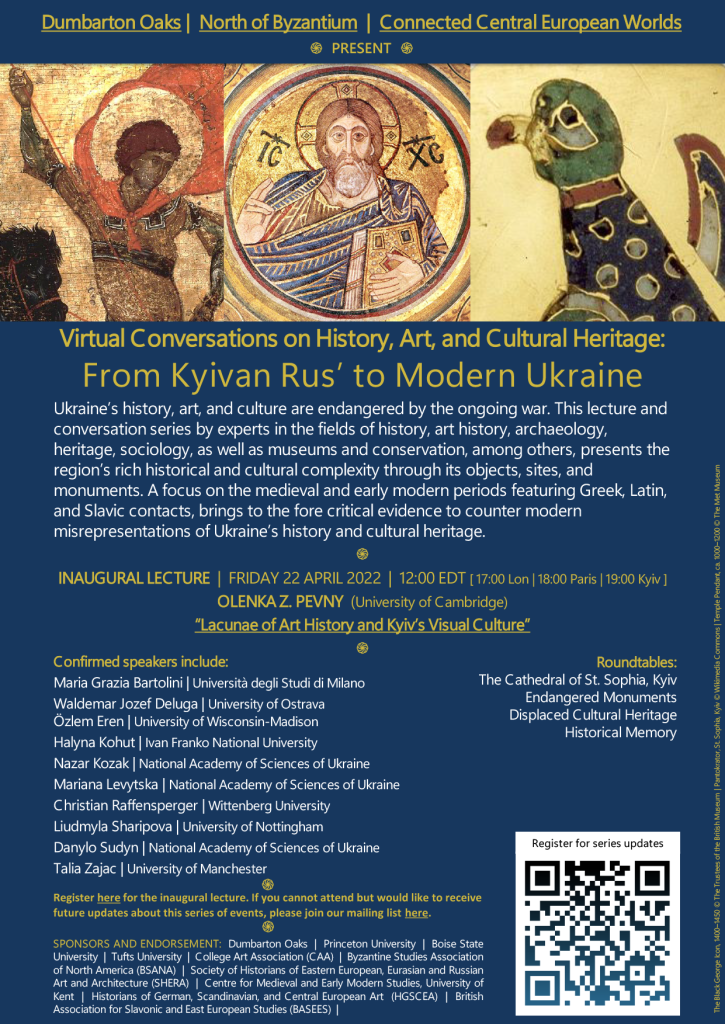
Future events include:
- May 2022 – Lecture: Mariana Levytska, National Academy of Sciences of Ukraine (The “Holy Rus’ concept” and Religious Art with Political Connotations (Pochaiv Monastery in 19th century)
- May 2022 – Discussion workshop on The Cathedral of St. Sophia, Kyiv
- June 2022 – Lecture: Christian Raffensperger, Wittenberg University (“Medieval Origins and Modern Constructs, Rus – Ukraine – Russia”)
- July 2022 – Lecture: Liudmyla Sharipova, University of Nottingham (Mazepa’s women before and after Poltava: to save and to keep)
- July 2022 – Discussion workshop on Endangered Monuments
- September 2022 – Lecture: Maria Grazia Bartolini, Università degli Studi di Milano (Reading the image of prince Volodymyr Sviatoslavych in seventeenth-century Kyiv)
- September 2022 – Discussion workshop on Displaced Cultural Heritage.
- October 2022 – Lecture: Nazar Kozak, Senior Research Scholar, Department of Art History, The Ethnology Institute, National Academy of Sciences of Ukraine Lviv (Images of Power and Their Discursive Site-Specificity in Kyivan Rus’)
- November 2022 – Lecture: Talia Zajac, University of Toronto (will speak about the marriages between the ruling clan of Rus’ and Latin Christian Europe or the translation and commentary on the eleventh-century prayerbook of Gertruda of Poland)
- November 2022 – Discussion workshop on historical memory.
- December 2022 – Lecture: Halyna Kohut, Associate Professor, Ivan Franko National University of Lviv (Taste, Social Class, and Oriental Carpet Design in the Eighteenth-Century Cossack Hetmanate)
SPONSORSHIP AND ENDORSEMENT:
- Dumbarton Oaks
- Princeton University
- Boise State University
- Tufts University
- Centre for Medieval and Early Modern Studies, University of Kent
- College Art Association (CAA)
- Byzantine Studies Association of North America (BSANA)
- British Association for Slavonic and East European Studies (BASEES)
- Historians of German, Scandinavian, and Central European Art (HGSCEA)
- Society of Historians of Eastern European, Eurasian and Russian Art and Architecture (SHERA)



